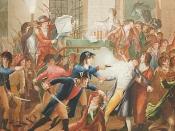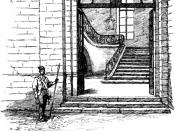On July 28, 1794 Maximilien Marie Isidore de Robespierre died on the guillotine, along with nineteen supporters and his close associates, Louis Saint-Just and Georges Couthon, for the simple want of order, an order that made Robespierre ultimately responsible for the guillotining of 16,000 people.
Robespierre began his political career on the eve of the French revolution when he was elected as a deputy of the Estates-General on March 31, 1789. He was an enemy of the monarchy, and harbored many noble ideas concerning equality, particularly regarding the under-privileged. He was made a member of the committee of public safety, which was given considerable power when the coalition was poised for an invasion of France. Robespierre was known as 'Incorruptible'. Maybe this is taken from his obsession of ridding France of all things corrupt. Unfortunately, his place of leadership with the Committee of Public Safety put him in a position where he was in control.
And so the reign of terror was set in motion, and everyone feared the guillotine.
On July 27, 1794 Robespierre had been a member of the Committee of Public Safety for exactly a year and his presence was becoming a source of extreme menace to most of his colleagues in the Convention and on both of the powerful Committees. Furthermore, the victory at Fleurus on June 26th had made the war an offensive, rather than defensive affair, which no longer warranted a wartime dictatorship as the Committees had been. The heat is another very important factor to consider. It was 104 degrees on 9 Thermidor; most of the men involved hadn't slept for over 48 hours and were living on caffeine, paranoia and adrenaline.
On the day of his execution, Robespierre was taken first to the Committee, where his jaw was bandaged (Robespierre had his...


